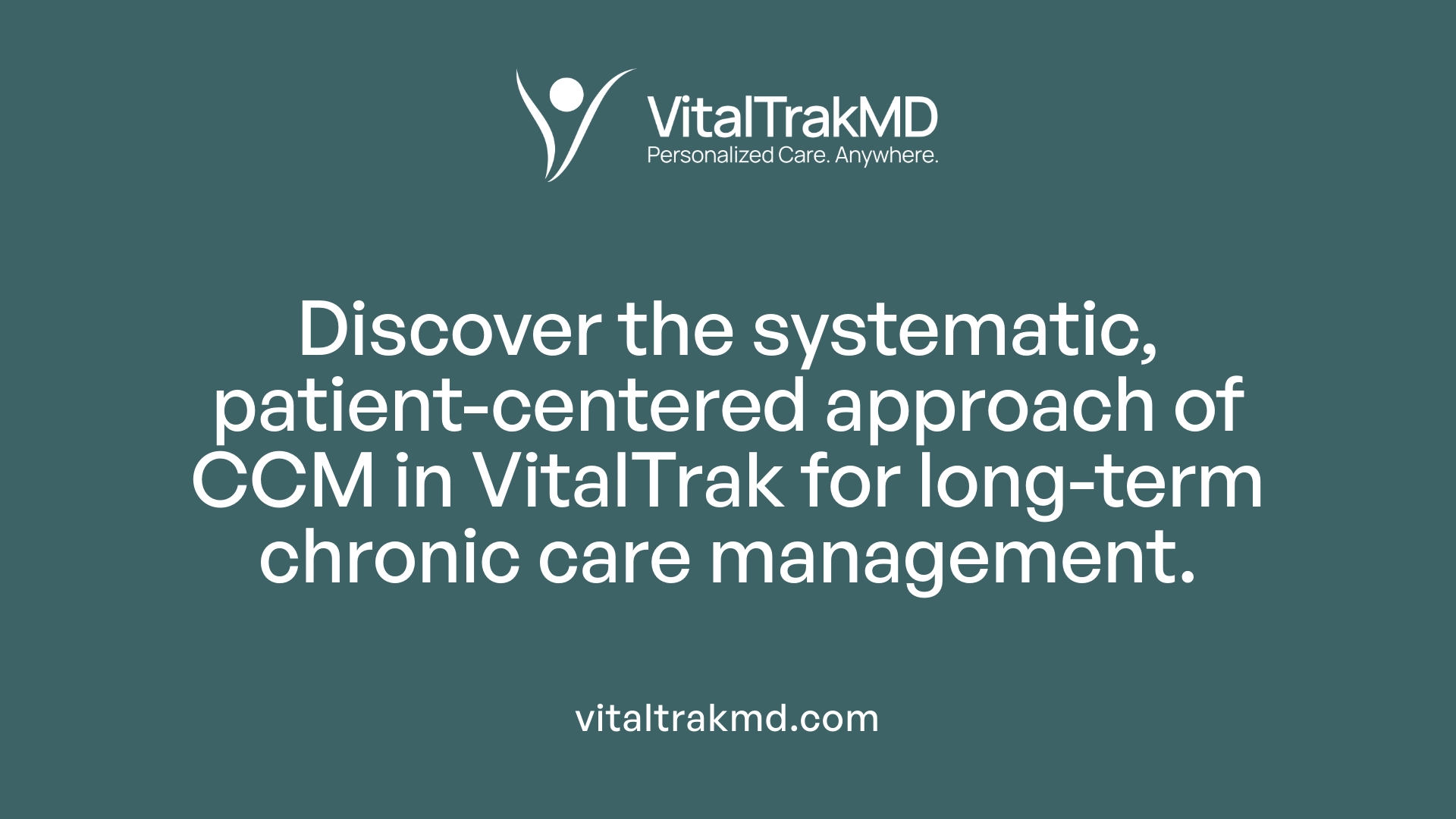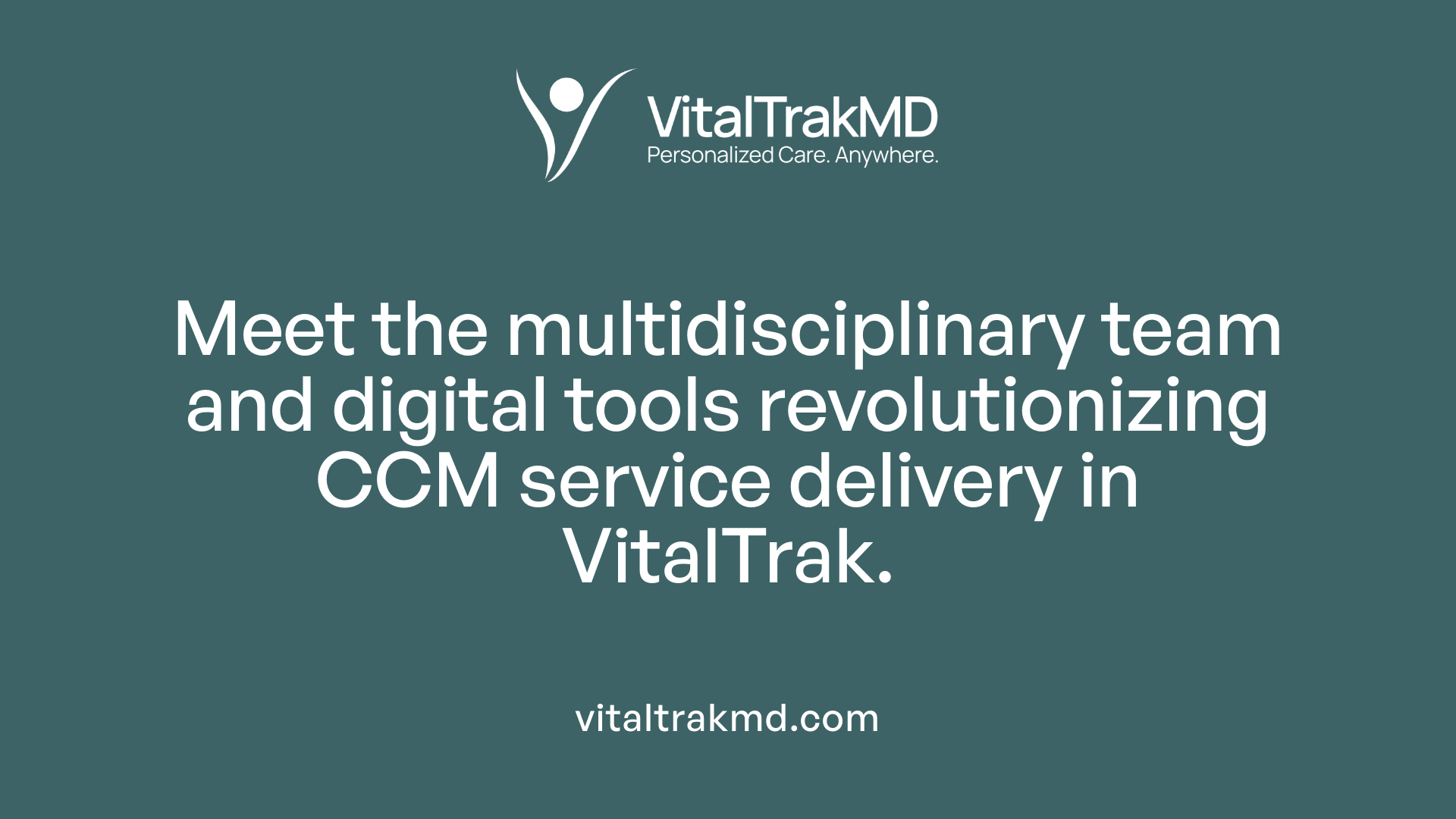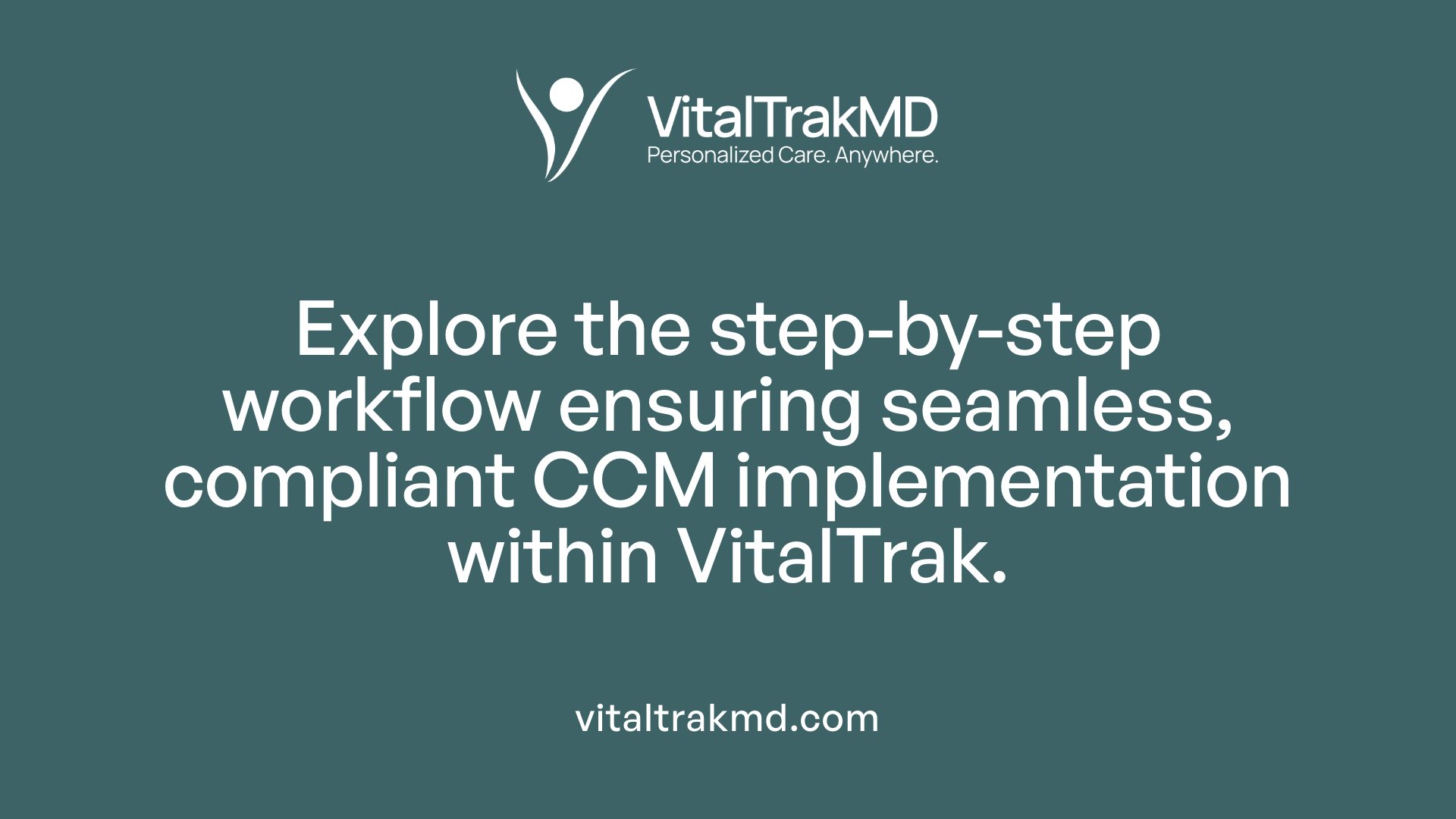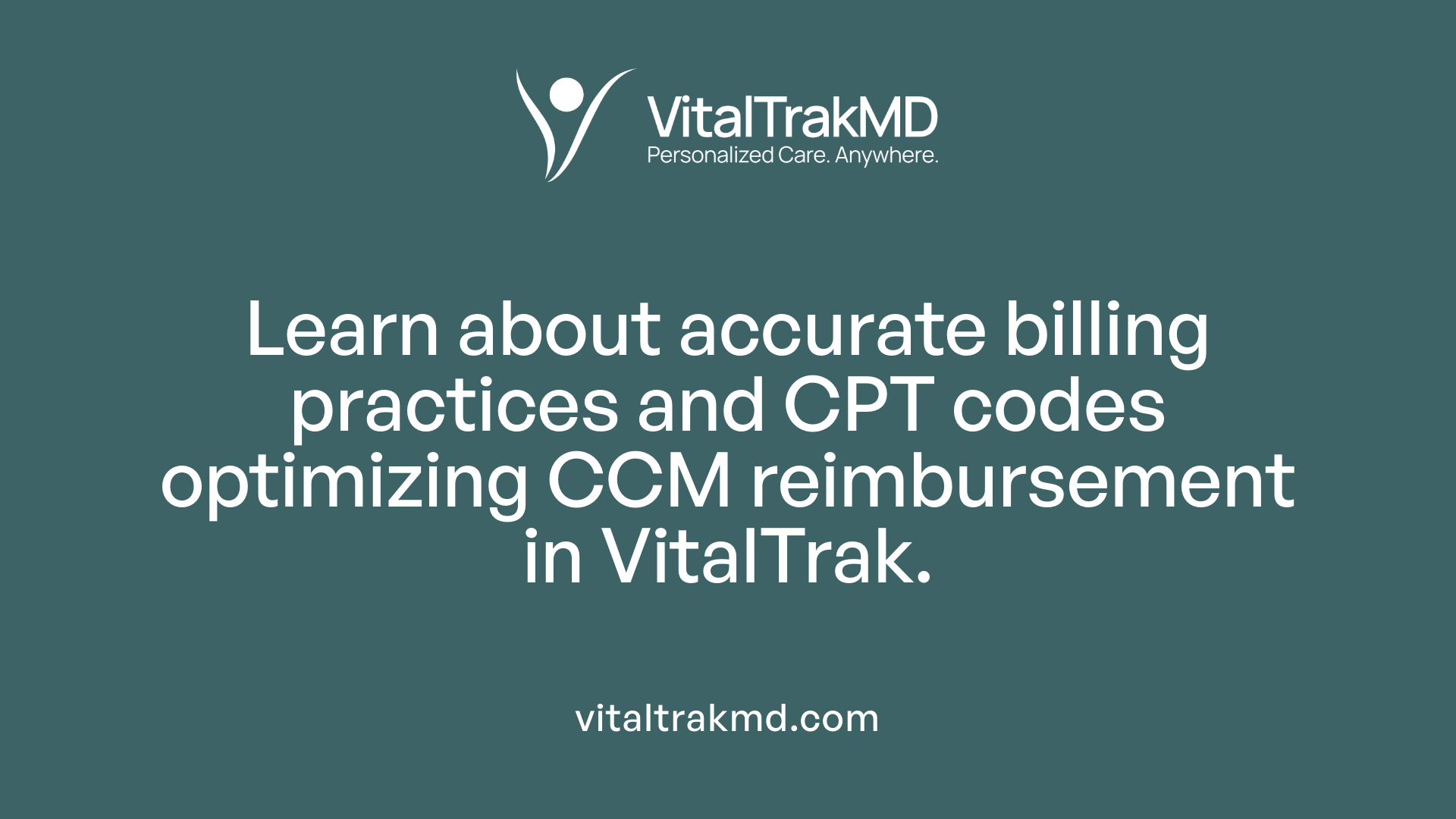How Chronic Care Management is Structured in VitalTrak Plans

Transforming Patient Outcomes with Integrated CCM Strategies
VitalTrak Plans exemplify a comprehensive, technology-enabled model for managing chronic conditions. By integrating advanced care planning, remote monitoring, and collaborative workflows, these plans aim to enhance patient engagement, reduce hospitalizations, and improve overall health outcomes. This article explores the structure, organizational components, processes, benefits, and compliance aspects of CCM within VitalTrak Plans, providing an in-depth understanding of how modern healthcare effectively manages chronic diseases.
Structured Framework of CCM in VitalTrak Plans

How is Chronic Care Management (CCM) structured within VitalTrak Plans?
VitalTrak Plans employs a systematic approach to managing chronic conditions, focusing on personalized, automated care delivery. The process begins with enrolling patients who have at least two chronic conditions expected to last for a minimum of 12 months or until their passing.
Once enrolled, patients receive tailored monthly care plans generated by the Vital Health Services platform. These plans are comprehensive, outlining essential health information such as current medical issues, treatment goals, medication lists, and details of healthcare providers involved in their care.
An important aspect of this system is the identification of social determinants of health, including factors like housing stability and transportation access. These are uncovered through social assessments integrated into the platform, enabling more holistic care.
All information from the personalized care plans is documented electronically, allowing seamless sharing with healthcare providers through electronic health records (EHRs). This integration promotes coordinated, consistent treatment and facilitates real-time updates.
Furthermore, dedicated implementation teams oversee the rollout and ongoing operation of CCM services across multiple care settings. They ensure adherence to healthcare standards and facilitate smooth collaboration among providers and locations.
The VitalTrak CCM structure, therefore, emphasizes a patient-centered, technologically supported, and team-driven approach to improve health outcomes and operational efficiency.
Organizational Components and Service Delivery

What components and organization are involved in CCM services in VitalTrak Plans?
CCM services within VitalTrak Plans are built around a multidisciplinary care team that collaborates to manage patients with multiple chronic conditions. This team typically includes physicians, nurse practitioners, clinical nurse specialists, and dedicated care coordinators. Each member plays a specific role, from developing personalized care plans to providing ongoing support and medical oversight.
The core of the program involves creating comprehensive, patient-centered care strategies. These plans integrate medical management, medication reconciliation, health education, and proactive monitoring of health status. Utilizing electronic health records (EHR) and digital health tools — such as Remote Patient Monitoring (RPM) devices — facilitates continuous tracking of vital signs and symptoms.
Care coordination activities are fundamental, ensuring seamless communication between providers and timely intervention when issues arise. This includes managing care transitions, sharing health information promptly with external providers, and engaging patients actively in their care. The goal is to foster better health outcomes, reduce hospital readmissions, and empower patients to participate in their health management.
Billing and enrollment procedures are designed to comply with CMS guidelines. Before initiating services, patients must undergo a face-to-face visit—either during a comprehensive evaluation, annual wellness visit, or another qualifying in-person encounter. Patients also provide written or verbal consent, which covers service availability, costs, and their rights.
Services are primarily delivered remotely—via phone, secure messaging, or telehealth—allowing for flexible, accessible care outside traditional office visits. Ongoing documentation ensures adherence to regulatory standards and supports reimbursement processes.
Overall, VitalTrak Plans’ CCM structure emphasizes proactive, coordinated care delivered by specialized teams, leveraging technology to enhance patient engagement and health management efficiency.
Processes and Workflow for CCM Implementation

What are the processes and workflows involved in implementing CCM within VitalTrak Plans?
Implementing Chronic Care Management (CCM) within VitalTrak Plans involves a series of well-defined steps designed to ensure quality, compliance, and patient engagement.
The process begins with patient enrollment during initial face-to-face visits, such as comprehensive annual wellness visits or routine evaluation and management sessions. During this visit, healthcare providers assess eligibility, confirm that the patient has at least two chronic conditions expected to last 12 months or until death, and obtain informed consent in verbal or written form. This consent covers service availability, billing procedures, and patient rights.
Once enrolled, the development of a personalized, evidence-based care plan is critical. The care plan includes detailed health information, problem lists, treatment goals, and specific instructions, all accessible to the patient, fostering transparency and engagement.
VitalTrak Plans leverage remote patient monitoring (RPM) technology to collect real-time health data such as vital signs, symptoms, and medication adherence. This continuous monitoring enables early detection of health issues and proactive intervention, significantly reducing hospitalizations.
Throughout this process, the care team—comprising physicians, nurse practitioners, clinical nurses, and other qualified professionals—coordinates closely through secure, HIPAA-compliant virtual infrastructure, including platforms like HealthSnap. Regular communication includes virtual check-ins, medication management, and updates on patient status.
Care team training ensures all members understand documentation, billing procedures, and the use of digital health tools. Addressing social determinants of health and connecting patients to community resources further enhance care outcomes.
Billing and reimbursement are achieved by adhering to specific CPT codes corresponding to the level of service time (e.g., CPT 99490, 99491), supported by detailed documentation in electronic health records.
VitalTrak Plans thus streamline workflows by integrating patient data, ensuring timely reviews, and maintaining continuous care through a structured, compliant, and patient-centered approach. This systematic process improves overall health outcomes, optimizes practice efficiency, and adheres to CMS guidelines.
Benefits and Features of CCM in VitalTrak Plans
Chronic Care Management (CCM) programs, as structured in VitalTrak Plans, offer numerous advantages for healthcare providers and patients alike. One of the primary benefits is the significant improvement in health outcomes for individuals with multiple chronic conditions. By developing personalized care plans tailored to each patient’s needs, these programs foster better disease management, increased medication adherence, and support for lifestyle modifications.
VitalTrak Plans utilize advanced digital health tools like remote patient monitoring (RPM). RPM allows continuous tracking of vital signs, symptoms, and medication usage, providing real-time data that facilitates early detection of health issues and enables proactive medical interventions. This consistent monitoring not only enhances personalized care but also helps prevent complications.
Another crucial feature of CCM in VitalTrak is its focus on care coordination. It ensures seamless communication among healthcare providers, managing care transitions, and sharing essential patient information efficiently. This coordinated approach reduces redundant testing, avoids medication conflicts, and promotes a holistic view of the patient's health.
A notable outcome of these features is a marked reduction in hospitalizations and emergency room visits. Studies show that integrating CCM with digital health solutions can decrease ER utilization by over 60%, significantly lowering healthcare costs and improving patient safety.
Overall, VitalTrak's CCM programs are designed to optimize resource use, streamline workflows, and support long-term health management, making them a valuable component in modern healthcare delivery.
Eligibility, Consent, and Documentation Procedures
What are the eligibility criteria and documentation procedures for CCM within VitalTrak Plans?
To qualify for Chronic Care Management (CCM) under VitalTrak Plans, patients must have two or more chronic conditions that are expected to last at least 12 months or until death. These conditions typically include ailments such as diabetes, hypertension, COPD, or heart failure. Patients need to be considered at significant risk of adverse outcomes like hospitalization or functional decline.
Before starting CCM services, an initiating visit is essential. This visit is typically a comprehensive face-to-face evaluation, which can be an Evaluation and Management (E/M) visit, an Annual Wellness Visit (AWV), or an Initial Preventive Physical Exam (IPPE). During this appointment, the healthcare provider assesses the patient's health status, establishes care needs, and develops a personalized care plan.
Patient consent is a mandatory step. Patients must provide either written or verbal informed consent prior to enrollment. This consent ensures they are aware of the services offered, any associated costs, billing limits, and their right to opt out at any time.
Critical to CMS compliance, thorough documentation is required. Healthcare providers must create and maintain an electronic, comprehensive care plan that captures the patient's health problems, management goals, and specific interventions. The care plan should be accessible to both the patient and all involved providers.
Ongoing documentation includes recording all interactions, such as care coordination activities, medication reviews, remote monitoring data, and patient communications. Clinicians must also document time spent on non-face-to-face services, especially the minimum 20 minutes per month dedicated by clinical staff, to justify billing and ensure quality standards.
Additional documentation involves secure sharing of health information, managing care transitions, and maintaining current problem lists, all aligned with CMS guidelines. This comprehensive approach facilitates continuous, coordinated, and personalized care, ultimately enhancing patient outcomes within VitalTrak Plans.
Reimbursement, Billing, and Coding

What are the billing and reimbursement procedures for CCM in VitalTrak Plans?
Billing for Chronic Care Management (CCM) services is structured and relies heavily on specific CPT codes that reflect the complexity and scope of care provided. Providers can utilize CPT codes 99490, 99491, 99439, and 99487 based on the level of the service activity, with each code corresponding to different levels of provider involvement and time commitment.
The process begins with thorough documentation of at least 20 minutes of clinical staff time dedicated to non-face-to-face activities each month. These activities include developing and updating personalized care plans, coordinating with other providers, medication reconciliation, and regular patient check-ins through phone or electronic messaging.
Proper coding requires timestamped entries in the electronic health record (EHR) for all patient interactions and documented care activities, aligning with CMS standards for billing accuracy and compliance.
Reimbursement rates are revised annually; for 2025, the rates are set to support sustainable practice operations and promote broader adoption of CCM services. The updated rates correlate with the specific CPT code used and reflect the effort involved in managing each patient’s chronic conditions.
In addition to basic CCM codes, extended service codes such as CPT 99439 and 99487 are used for situations requiring more time and greater level of medical decision-making. These codes ensure comprehensive billing coverage.
In summary, the billing process involves precise documentation, meticulous coding, adherence to time requirements, and understanding of updated reimbursement rates. Successful implementation ensures providers are fairly compensated for delivering high-quality, continuous care to their patients, while also complying with federal guidelines.
Integration with Remote Patient Monitoring (RPM) and Digital Tools
Technology integration plays a vital role in modern Chronic Care Management (CCM) programs. Within platforms like VitalTrak Plans, RPM devices such as blood pressure monitors, glucose meters, and wearable trackers are incorporated to provide continuous health data. This seamless connection allows healthcare providers to monitor patients remotely and in real-time.
RPM data sharing is designed to be secure, ensuring patient privacy while enabling clinical staff to analyze vital signs and symptom reports promptly. This ongoing data flow supports early detection of health deterioration, allowing for proactive interventions before conditions escalate to emergencies.
Early detection and intervention are key benefits of integrating RPM with CCM. Platforms like DrKumo and HealthSnap facilitate device management and data transmission, enabling care teams to make timely adjustments to treatment plans. This approach reduces hospital readmissions and enhances patient engagement by giving patients access to their health metrics.
Through the combination of digital tools and remote monitoring, VitalTrak Plans offers a comprehensive, responsive care model that addresses the complexities of managing multiple chronic conditions effectively.
Role of Care Teams and Digital Infrastructure
What are the operational and operational aspects of CCM in VitalTrak Plans?
Operationally, CCM within VitalTrak Plans is centered around a dedicated, multidisciplinary care team that includes physicians, nurse practitioners, specialist consultants, and care coordinators. These professionals collaborate closely to deliver comprehensive, personalized care tailored to each patient's chronic conditions.
VitalTrak leverages a robust digital infrastructure, notably platforms like VitalHealth Links and HealthSnap, which enable secure documentation, data sharing, and analysis of patient information. These tools facilitate real-time updates on health status, support telehealth interactions, and streamline communication among team members.
Care teams are thoroughly trained in evidence-based care practices, digital tool usage, and proper billing protocols. This training ensures they can efficiently utilize the technology to improve care quality, stay compliant with CMS requirements, and maximize billing opportunities.
The digital infrastructure supports seamless care coordination by allowing instant access to patient records, medication lists, and care plans. It enables proactive management through features such as messaging systems, scheduling, and alerts for health milestones or deterioration.
Moreover, the care team uses integrated assessments to address social determinants of health, connecting patients with community resources and social support services. This holistic approach helps address factors affecting health outside of clinical settings.
Overall, this operational model ensures CCM activities are efficient, data-driven, and patient-centered. It promotes continuous monitoring, early intervention, and improved health outcomes—aligning with CMS standards and quality performance benchmarks, ultimately enhancing the effectiveness of VitalTrak’s CCM programs.
Conclusion and Future Directions
How does CCM impact healthcare quality?
Chronic Care Management (CCM) plays a crucial role in elevating healthcare quality by fostering continuous, personalized, and coordinated care for patients with long-term conditions. It reduces hospital readmissions, improves medication adherence, and enhances patient engagement in managing their health. Effective CCM ensures that care plans are tailored to individual needs, leading to better health outcomes and higher patient satisfaction.
What are the recent advances in digital health supporting CCM?
Innovations in digital health, such as remote patient monitoring (RPM) and integrated electronic health records (EHR), have transformed CCM delivery. RPM devices enable real-time tracking of vital signs and symptoms, providing clinicians with continuous data to make timely interventions. Digital tools facilitate seamless communication between patients and providers, allowing for efficient care adjustments and education outside traditional in-person visits.
How are sustainable care models evolving?
Sustainable care models emphasize scalability, cost-effectiveness, and adaptability through technology and team-based approaches. Programs like VitalTrak Plans leverage digital health solutions to monitor multiple patients efficiently while maintaining personalized care. These models focus on integrating social determinants, community resources, and patient preferences to optimize outcomes long-term.
| Aspect | Current Status | Future Outlook | Additional Notes |
|---|---|---|---|
| Impact on Healthcare | Improves outcomes, reduces costs | Continued enhancement with AI and data analytics | Focus on outcome-based measures |
| Digital Health Advances | RPM, telehealth, EHR integration | Expansion with wearables, predictive analytics | Increased patient empowerment |
| Care Models | Patient-centered, team-based | Fully integrated, AI-supported, adaptable | Emphasis on value-based care |
What is the overall impact and future outlook of CCM in VitalTrak Plans?
The overall impact of CCM in VitalTrak Plans is significant, demonstrating improvements in healthcare quality, patient outcomes, and system efficiency. By utilizing advanced digital tools, real-time data sharing, and proactive care management, these plans reduce hospitalizations, enhance medication adherence, and empower patients to participate actively in their health journey. The future of CCM in VitalTrak hinges on technological innovations such as AI-driven analytics, expanded telehealth services, and integration with broader healthcare systems. These developments promise to make CCM more accessible, personalized, and cost-effective, sustaining its role as a cornerstone in long-term chronic disease management. As healthcare ecosystems evolve towards value-based models, VitalTrak's structured, data-supported approach will continue to set standards for comprehensive, patient-centered chronic care.
Summing Up the VitalTrak CCM Strategy
VitalTrak Plans exemplify how integrated, technology-driven CCM can transform chronic disease management. By focusing on personalized care, seamless data sharing, and proactive interventions, they improve patient health, reduce costs, and set a sustainable standard for modern healthcare. The continuous evolution of digital health tools and collaborative workflows promises an even more effective future for CCM, ensuring long-term wellness and enhanced quality of life for patients with complex health needs.
References
- 6 Key Components of an Effective Chronic Care Management ...
- [PDF] MLN909188 – Chronic Care Management Services - CMS
- What is CCM and RPM? - ThoroughCare
- Chronic Care Management: Services Your Patients Need
- What is Chronic Care Management: A Complete Guide 2025
- Power Of A Patient Centered Chronic Care Management Care Plan ...
- Chronic Care Management Guide | APEX Health Services
- The Benefits of CCM for Patients - Signallamp Health
- What is Chronic Care Management? Examples, Guidelines & More
- The Benefits of Integrating RPM and CCM - Prevounce Blog
Recent articles
Want to Feel Better and Live Healthier?
Join hundreds of patients taking control of their health with personalized care that fits their life – not the other way around.
Rated 4.8/5 by 32+ customers







